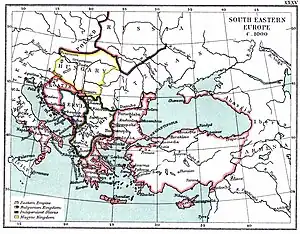Byzantine–Venetian treaty of 1082
The Byzantine–Venetian treaty of 1082 was a trade and defence pact signed between the Byzantine Empire and the Republic of Venice, in the form of an imperial chrysobull or golden bull, issued by Emperor Alexios I Komnenos. This treaty, which provided the Venetians with major trading concessions in exchange for their help in the wars against the Normans, would have a major impact on both the empire and the republic that would later dictate their histories for several centuries to come.
 The Byzantine Empire and neighbouring countries at the beginning of the 11th century | |
| Type | Chrysobull |
|---|---|
| Context | Byzantine–Norman wars |
| Signatories | |
Stipulations
The Byzantine Empire made a large number of trade concessions to the Republic of Venice in exchange for military support against the Normans who were invading and conquering various Byzantine holdings in and outside the empire. According to the treaty, the Byzantines would allow the Venetians the right to trade throughout the empire without the imposition of taxes.[1] The Venetians would also be allowed control of the main harbor facilities of Byzantium (Constantinople), along with control of several key public offices.[2] The treaty also granted various honors to the Doge of Venice, along with an income.[1] Finally, the Venetians were granted their own district within Byzantium, with shops, a church, and a bakery,[3] which could be compared to the concessions of 19th century colonialism.
In exchange for these trade concessions, the Byzantine Empire requested military support from the Venetians, especially in the form of ships, since the empire had no real navy to speak of.
Consequences
The military aid promised by the Republic of Venice never really arrived. The Venetians did not really do anything to halt the Normans, but reaped great benefits from the new trade advantages they enjoyed by the treaty.[2] The Byzantine Empire’s ability to recuperate after losses was significantly reduced, because of the immense revenue the empire had given up when it allowed the Venetians to trade freely without the imposition of taxes. This stifled the empire’s power of recuperation and ultimately started its terminal decline.[2]
See also
Notes
- Gregory.
- Bideleux.
- Constable.
References
- Bideleux, Robert and Ian Jeffries (1998). A History of Eastern Europe: Crisis and Change. London: Routledge. ISBN 978-04151-6112-1.
- Constable, Olivia Remie (2003). Housing the Stranger in the Mediterranean World: Lodging, Trade, and Travel in Late Antiquity and the Middle Ages. Cambridge: Cambridge University Press. ISBN 978-0521-81918-3.
- Gregory, Timothy E. (2010). A History of Byzantium. Malden, Massachusetts: John Wiley & Sons. ISBN 978-1405-18471-7.
Further reading
- Frankopan, Peter (2004). "Byzantine Trade Privileges to Venice in the Eleventh Century: The Chrysobull of 1092". Journal of Medieval History. Elsevier. 30 (2): 135–60. doi:10.1016/j.jmedhist.2004.03.005. Archived from the original on 2008-10-14. Retrieved 2014-12-08.
- Nicovich, John Mark (2009). "The Poverty of the Patriarchate of Grado and the Byzantine–Venetian Treaty of 1082". The Mediterranean Historical Review. New York: Routledge. 24 (1): 1–16. doi:10.1080/09518960903000736.
- Ostrogorsky, George (1956). History of the Byzantine State. Blackwell. ASIN B0000CJHS9.